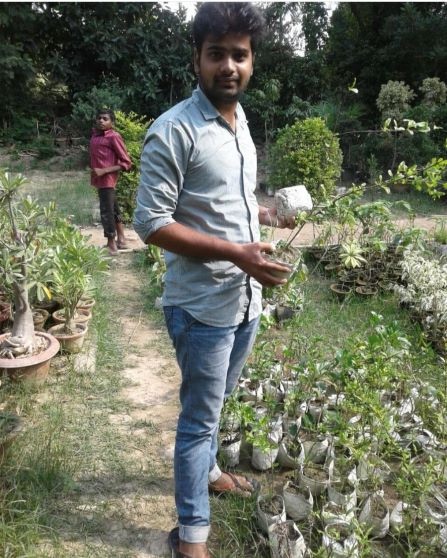A very common citric fruit, the lemon found in our kitchens has gained more importance in recent months. Rich in Vitamin-C, the fruit is a good immune booster, providing much-needed nutrition when the Covid-19 pandemic is at its peak.
Many people now want to grow lemon at home. But this particular idea becomes a challenge for city dwellers who are crunched for space and know little about growing a lemon tree – which normally requires sizeable space.
So is it possible to grow a lemon tree in your balcony or on a small terrace?
Aakash Jaiswal from Kanpur has an answer to the question. The expert started gardening at the age of 14 and has grown a variety of vegetables in his terrace garden. Aakash currently runs a YouTube channel – Gardening lovers – and has over 6.5 lakh subscribers.
“My terrace garden is full of 250 varieties of fruits, vegetables and decorative species of plants,” Aakash says, assuring that it is quite possible to have a fully grown lemon tree in small spaces.
Getting the right plant

Aakash says that getting the right pick at the plant from your nearby nursery is the most crucial factor. “The quality of the sapling should be good. An easy way to spot it is by having a sapling bearing more flowers,” he adds.
What size fits it?
The branches of a lemon tree spread wide and so will the roots of the plant. “It would be advisable to get a pot that is 16-18 inches wide, to ensure the plant is not suffocating,” Aakash says.
Space allows a good spread of the roots and retains moisture. “Suffocating the roots often leads to root binding and that will not allow the plant to attain full growth,” he adds.
The best mix
Once the plant and the pot are ready, the next important step is to prepare the soil mixture. This is perhaps the most crucial stage as the plant will get all its nutrition from this soil.
Aakash says the soil should have 40 per cent of organic manure or fertiliser. “Vermicompost, cow dung and other organic feed usually work best. The remaining part of the mixture should be gardening soil, which is normally mixed with sand,” the expert says.
Nurture it like a baby
Your job is only getting started after the plant is potted. While it settles in new surroundings, there are many factors like the location of the plant to consider.
The plant should also be on a stable platform or base.
“The lemon plant requires plenty of sunlight, and keeping it in a shadow would not be ideal. Having direct sunlight on the plant is best. Also, avoid having the plant in a windy area,” Aakash says cautioning that watering of the plant more than needed will only cause damage.
Aakash says the best way to water the plant is in a gap of 2-3 days. “The water quantity should be limited, but adequate. Do not pluck or damage the fresh green leaves as it will affect the healthy growth of the plant,” Aakash says.
The gardening expert said adding some cow dung manure after a month and a half of potting the plant will help to give added nutrition.
My plant is bearing few flowers
“If you feel the size of the flowers is smaller than the normal, an easy way to solve the issue is by sprinkling honey over the plant. The simple trick will assist pollination from bees and help the flowering process,” Aakash says.
Year-long fruiting
There are some varieties of lemon found in the market including paper lemon, the grafted variety and seedless lemons. “Many people also choose to grow seedless lemon, Some prefer to grow Chinese lemon which are much smaller in size and look ornamental,” Aakash says.
“Seedless lemon varieties often grow faster and bear fruit in about two years. While, if you’re ready to be patient, the indigenous plant variety will give you fruit in five years,” Aakash adds.
Aakash adds that seedless lemons are in much demand in recent times and the lemon tree bears fruit through the year. “Having a lemon tree in your terrace or balcony is one of the best things you need to boost your immunity in pandemic times,” he says.
Click here to watch a video about growing lemons. You can also email Aakash at Aakashjaiswal0808@gmail.com.
(Edited by Vinayak Hegde)
If you found our stories insightful, informative, or even just enjoyable, we invite you to consider making a voluntary payment to support the work we do at The Better India. Your contribution helps us continue producing quality content that educates, inspires, and drives positive change.
Choose one of the payment options below for your contribution-
By paying for the stories you value, you directly contribute to sustaining our efforts focused on making a difference in the world. Together, let's ensure that impactful stories continue to be told and shared, enriching lives and communities alike.
Thank you for your support. Here are some frequently asked questions you might find helpful to know why you are contributing?

